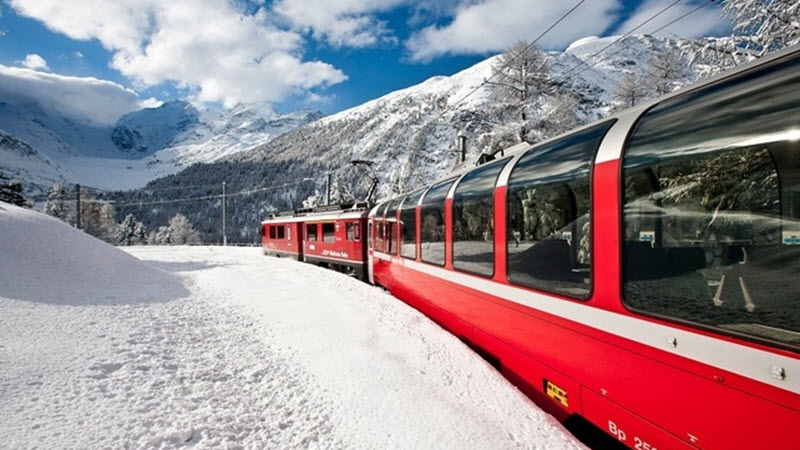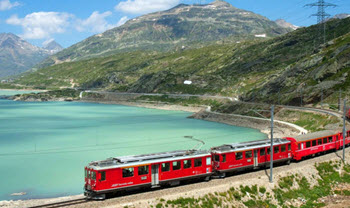
The Bernina Express will take you from Chur in Switzerland through Poschiavo and all the way to Tirano on the other side of the Italian border. The journey goes through the beautiful Swiss Engadin Alps and you will be travelling on a World Heritage Site known as The Rhaetian Railway in the Albula / Berninan Landscapes.
The train, operated by the Rhaetian Railway, features panorama cars and is a popular tour for sightseeing. The panoramic coaches have enlarged windows and there is an audio guide available onboard in several languages, including English.
During the summer season, the Bernina Express is a special separate train that makes very few stops along the way. In Pontresina, the locomotive is changed to fit the Berninan line’s electric current. During the rest of the year, the Bernina Express consists of a few cars attached to an ordinary regional train. This means that a much larger number of stops will be made.
Itinerary
The journey consists of two parts: the Albula line and the Bernina line. In 2008, the lines were jointly declared a World Heritage Site. The Albula line was built in 1898 – 1904 and the Bernina line was added in 1908-1910.
During your journey, you will:
- Travel over 196 bridges
- Go through 55 tunnels
- Reach a point 2 253 meters above sea level
The Albula line from Chur to St. Moritz
The journey starts in Chur, a city located 585 meters above sea level in Graubünden, Switzerland. The railway then follows the course of the river Rhineto Bonaduz, from which it enters the beautiful Domleschg Valley and follows the Posterior Rhine from Rhäzüns to Thusis.
 The Albula line continues from Thusis toward Tiefencastle, following the Albula and then crossing the Landwasser Viaduct to get to Filisur. You are now more than one thousand meters above sea level. The Landwasser Viaduct (Landwasserviadukt) is a single track six-arched curved limestone railway viaduct over the river Landwasser, designed by Alexander Acatos and built in 1901-1902. It’s considered a signature structure for the Albula Railway.
The Albula line continues from Thusis toward Tiefencastle, following the Albula and then crossing the Landwasser Viaduct to get to Filisur. You are now more than one thousand meters above sea level. The Landwasser Viaduct (Landwasserviadukt) is a single track six-arched curved limestone railway viaduct over the river Landwasser, designed by Alexander Acatos and built in 1901-1902. It’s considered a signature structure for the Albula Railway.
After Filisur, the train passes its first spiral tunnel, before getting to Bergün/Bravuogn. After this station, there will be plenty of other spirals to go through, because the train must achieve a difference in height of roughly 400 meters with an horizontal distance of 5 km without using rack-and-pinion to get to Preda – a town located 1789 metes above sea level.
At an elevation of 1815 meters, the train will go into the Albula Tunnel. With a maximum elevation of 1 820 meters, it is one of the highest tunnels in the Alps and it has a mountain overlay of up to 950 meters. The tunnel, built in 1898 – 1904, is 5 865 meters long and connects the Albula Valley with the Engadin Valley, passing under the watershed between the Rhine and the Danube a few kilometres west of the Albula Pass. A totalt of 1 316 people were employed to build the tunnel and 16 of the tunnel workers died in fatal accidents during the project. At Preda station, there is a stone memorial commemorating them.
When the Bernina Express emerges from the tunnel, you will be in the Val Bever, traveling towards the Bever station on the Engadin plain. The elevation at Bever is 1708 meters. After Bever, the journey continues to Semadan and then to the railwaystation in St Moritz. St Moritz is the end of the Albula line and the start of the Bernina line.
The Bernina line from St. Moritz to Tirano
The Bernina line starts in St. Moritz, a high Alpine resort in the Engadine in Switzerland, at an elevation of about 1,800 metres. St. Moritz lies on the southern slopes of the Albula Alps, below the Piz Nair mountain. St. Moritz has been a winter resort since the 19th century, when students from Oxford and Cambridge would come here to play bandy against each other.
After leaving St. Moritz, the Bernina line goes to Pontresina in the Bernina Valley, before ascending gradually down through the valley to the Bernina Pass. During parts of the journey, it is possible so see Piz Bernina, the highest summit of the Eastern Alps (4093 meters above sea level).
When the Bernina Express reaches the Ospizio Bernina station, you are 2 253 meters above sea level, with the Lago Bianco below you at 2 234 m. This is the summit of the Bernina Express.
The first stop south of the Alps is Alp Grüm, which is below the mountain Piz Palü and above the lake Lago Palü. It is now time for numerous hairpin turns to bring you down to Cavaglia (1693 m) and then to Poschiavo (1014 meters). You are still in Switzerland, but you are getting close to the border and the official language in Poschiavo and its surrounding valley is Italian. The train will continue downwards, following the course of the Poschiavino river and stopping in Li Curt, Le Prese and Miralago. Both Le Prese and Miralago are located on the shore of the Poschiavo lake.
After Miralago, the journey continues to Brusio and through the spiral Brusio Viaduct. The last stops in Switzerland are Campascio and Campocologno. Campocologno is just 553 meters above sea level.
After crossing into Italy, the Bernina Express reaches its final destination in Tirano, at an elevation of 430 m. Despite having a population of less than 10, 000 people, Tirano has two neighbouring railway stations. One is a standard gauge station operated by Trenitalia, while the other is a metre gauge station operated by Rhaetian Railway. You will arrive at the metre gauge station.
List of stops
Major stations are listed in capital letters.
CHUR
- Reichenau-Tamins
THUSIS
- Tiefencastel
FILISUR
- Bergün/Bravuogn
- Preda
SAMEDAN
- Punt Muragl
PONTRESINA
- Surovas
- Morteratsch
- Bernina Suot
- Bernina Diavolezza
- Bernina Lagalb
OSPIZIO BERNINA
ALP GRÜM
- Cavaglia
- Cadera
- Privilasco
POSCHIAVO
- Li Curt
- Le Prese
- Miralago
- Brusio
- Campascio
- Campocologno
- Border between Switzerland and Italy
- Tirano
Basic information about the Bernina Express
| Current operator | Rhaetian Railway |
| Service type | Inter-city |
| Rolling stock | Panorama |
| Track gauge | 1,000 mm |
| Electrification | 11 kV AC 16⅔ Hz (core network) 1,000 V DC (Bernina line) |
| Route | Chur, Switzerland – Tirano, Italy |
| Service frequency | Daily |
| Average journey time | 4 hours |
| Classes | 1st class
2nd class |
| Disabled access | Yes |
| Catering facilites | Minibar |
| Observation facilities | Panorama cars |
